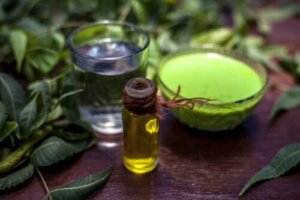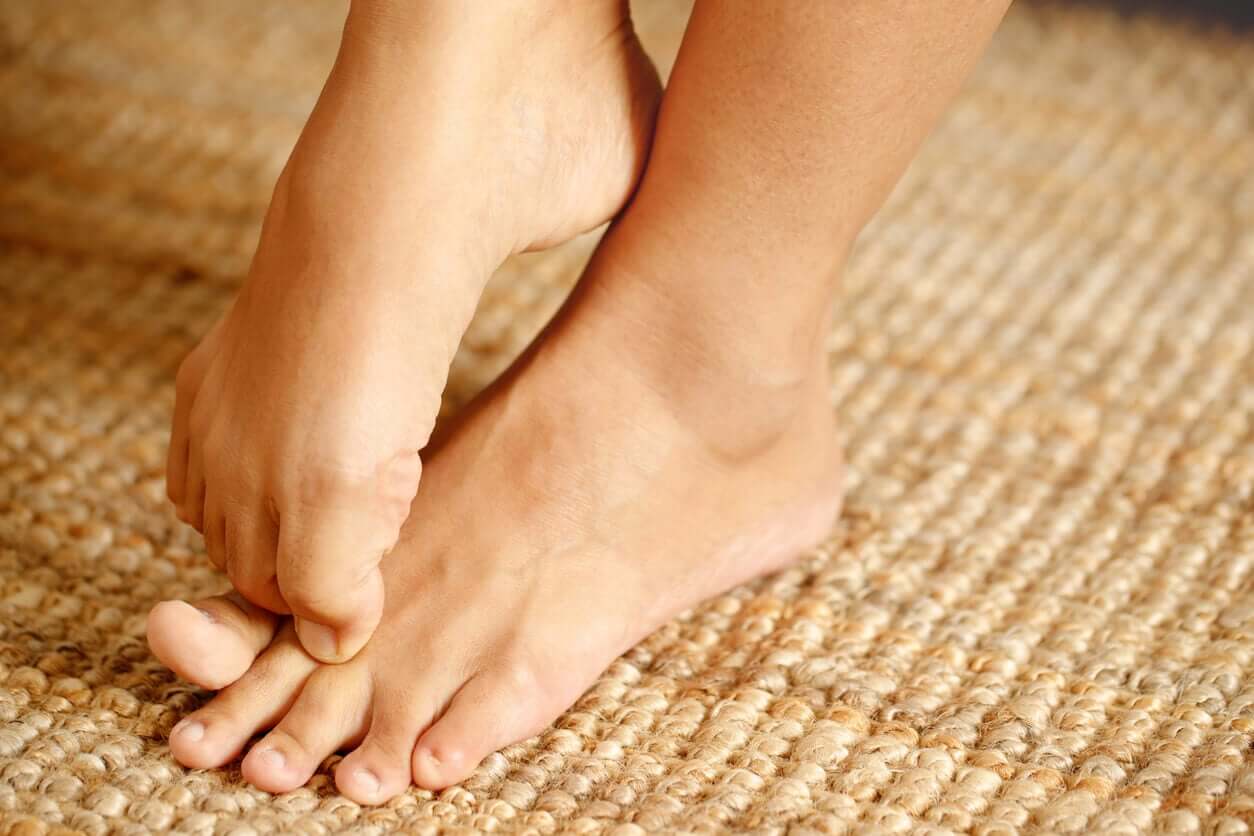10 Home Remedies for Skin Fungus


Written and verified by the dermatologist Maria del Carmen Hernandez
Fungal infections of the skin, hair, and nails are one of the most frequent motives for consultations in dermatology. The skin’s the barrier that separates the body from external threats and that’s why it’s so important to tend to any type of injury that occurs in time. Home remedies are a good complement to pharmacological treatment, but they’re not as effective if they’re the only strategy you use. Do you know of any home remedies for skin fungus? In this article, we’ll tell you the 10 most common. Take note!
Natural treatments for skin fungus
Although there are home remedies for skin fungus, these don’t have the same effectiveness as the pharmacological treatments indicated by a doctor. Therefore, in the presence of a lesion compatible with a mycosis, it’s always necessary to go to see a dermatologist.
Here are some of the actions that can be taken to prevent and treat these infections.
1. Probiotic supplements

Probiotic supplements can offer a significant improvement when it comes to yeast infections. In addition, they can be purchased in pharmacies without the need to present a prescription.
There are some formulations intended for the treatment of vaginal fungal infections that seek to restore the balance of the microbiota. These products are generally placed vaginally or taken by mouth.
2. Correct drying of the skin surface
One of the most important care measures is to always keep the skin clean and dry to prevent fungi from developing or from continuing their proliferation.
In general, mycosis that appears between the fingers (interdigital) is the most common form. For this reason, it’s important to dry this area properly and then apply talcum powder to avoid humidity.
3. Cotton socks
The use of cotton socks is recommended to absorb perspiration from the feet and avoid skin maceration. Therefore, it’s best not to use nylon stockings or those made with other synthetic fabrics.
4. Over-the-counter antifungal medications
There are multiple medications to combat fungi that are for topical use, such as lotions, creams, antifungal lacquers, or gels.
In general, the treatments with these products last three weeks, but in the case of nail conditions, these can last up to a year.
In order to fight the fungus, the main thing is to conduct a laboratory study to detect the variant that causes the infection. Then, based on the germ found, the most appropriate treatment is indicated: Clotrimazole, terbinafine, miconazole, or ketoconazole.
Read also: Erythema Nodosum in Children: Symptoms, Causes and Treatment
5. Open and ventilated footwear
It’s important to choose open shoes to avoid maceration, humidity, excess sweat, and foot occlusion. In contrast, closed shoes that don’t have adequate ventilation or shoes made of plastic favor sweaty feet and bad odor.
The use of talcum powder in areas of the body with a lot of sweating is also useful, as this cosmetic offers a cooling effect and prevents excess moisture and sweat.
6. Botulinum toxin
Some fungi have a predilection for humidity and heat, which makes them easier to treat and prevent. There are multiple therapeutic options for hyperhidrosis, from botulinum toxin infiltrations to sympathectomy.
7. Daily moistening
It’s essential to keep the skin dry and moisturized, especially on the feet, in the interdigital regions, and in those areas of the body that sweat excessively.
We must be careful not to apply the emollient cream under the nails so as not to predispose them to the development of fungi in that area.
You may be interested: Color Changes in Children’s Nails: What Do They Mean?
8. Covered feet, always protected
Humid environments are those with the greatest predilection for these microorganisms. Therefore, when you share changing rooms, swimming pools, or collective showers, it’s advisable to always wear sandals or flip-flops and not take off your shoes. Fungi are spread quite easily by direct contact and are found everywhere.
9. Personal footwear
Fungal infections, especially those of the interdigital regions or athlete’s foot, are highly contagious. Therefore, it’s not a good idea to exchange clothing or shoes between people.
In addition, you should change underwear and socks every day and allow footwear to ventilate outdoors.

10. Tea tree oil
Tea tree oil has antifungal properties that make it ideal for removing yeasts and fungi from the skin’s surface. A recently published study by Molecules confirms its fungicidal properties, which are enhanced with the use of antifungal drugs.
Regarding home remedies for skin fungus
In short, fungi on the skin are common at any age and their manifestations in this tissue can negatively alter the quality of life of those who suffer from it.
Therefore, even if they don’t involve serious symptoms, you should go to the dermatologist to receive the most appropriate treatment in a timely manner.
Fungal infections of the skin, hair, and nails are one of the most frequent motives for consultations in dermatology. The skin’s the barrier that separates the body from external threats and that’s why it’s so important to tend to any type of injury that occurs in time. Home remedies are a good complement to pharmacological treatment, but they’re not as effective if they’re the only strategy you use. Do you know of any home remedies for skin fungus? In this article, we’ll tell you the 10 most common. Take note!
Natural treatments for skin fungus
Although there are home remedies for skin fungus, these don’t have the same effectiveness as the pharmacological treatments indicated by a doctor. Therefore, in the presence of a lesion compatible with a mycosis, it’s always necessary to go to see a dermatologist.
Here are some of the actions that can be taken to prevent and treat these infections.
1. Probiotic supplements

Probiotic supplements can offer a significant improvement when it comes to yeast infections. In addition, they can be purchased in pharmacies without the need to present a prescription.
There are some formulations intended for the treatment of vaginal fungal infections that seek to restore the balance of the microbiota. These products are generally placed vaginally or taken by mouth.
2. Correct drying of the skin surface
One of the most important care measures is to always keep the skin clean and dry to prevent fungi from developing or from continuing their proliferation.
In general, mycosis that appears between the fingers (interdigital) is the most common form. For this reason, it’s important to dry this area properly and then apply talcum powder to avoid humidity.
3. Cotton socks
The use of cotton socks is recommended to absorb perspiration from the feet and avoid skin maceration. Therefore, it’s best not to use nylon stockings or those made with other synthetic fabrics.
4. Over-the-counter antifungal medications
There are multiple medications to combat fungi that are for topical use, such as lotions, creams, antifungal lacquers, or gels.
In general, the treatments with these products last three weeks, but in the case of nail conditions, these can last up to a year.
In order to fight the fungus, the main thing is to conduct a laboratory study to detect the variant that causes the infection. Then, based on the germ found, the most appropriate treatment is indicated: Clotrimazole, terbinafine, miconazole, or ketoconazole.
Read also: Erythema Nodosum in Children: Symptoms, Causes and Treatment
5. Open and ventilated footwear
It’s important to choose open shoes to avoid maceration, humidity, excess sweat, and foot occlusion. In contrast, closed shoes that don’t have adequate ventilation or shoes made of plastic favor sweaty feet and bad odor.
The use of talcum powder in areas of the body with a lot of sweating is also useful, as this cosmetic offers a cooling effect and prevents excess moisture and sweat.
6. Botulinum toxin
Some fungi have a predilection for humidity and heat, which makes them easier to treat and prevent. There are multiple therapeutic options for hyperhidrosis, from botulinum toxin infiltrations to sympathectomy.
7. Daily moistening
It’s essential to keep the skin dry and moisturized, especially on the feet, in the interdigital regions, and in those areas of the body that sweat excessively.
We must be careful not to apply the emollient cream under the nails so as not to predispose them to the development of fungi in that area.
You may be interested: Color Changes in Children’s Nails: What Do They Mean?
8. Covered feet, always protected
Humid environments are those with the greatest predilection for these microorganisms. Therefore, when you share changing rooms, swimming pools, or collective showers, it’s advisable to always wear sandals or flip-flops and not take off your shoes. Fungi are spread quite easily by direct contact and are found everywhere.
9. Personal footwear
Fungal infections, especially those of the interdigital regions or athlete’s foot, are highly contagious. Therefore, it’s not a good idea to exchange clothing or shoes between people.
In addition, you should change underwear and socks every day and allow footwear to ventilate outdoors.

10. Tea tree oil
Tea tree oil has antifungal properties that make it ideal for removing yeasts and fungi from the skin’s surface. A recently published study by Molecules confirms its fungicidal properties, which are enhanced with the use of antifungal drugs.
Regarding home remedies for skin fungus
In short, fungi on the skin are common at any age and their manifestations in this tissue can negatively alter the quality of life of those who suffer from it.
Therefore, even if they don’t involve serious symptoms, you should go to the dermatologist to receive the most appropriate treatment in a timely manner.
All cited sources were thoroughly reviewed by our team to ensure their quality, reliability, currency, and validity. The bibliography of this article was considered reliable and of academic or scientific accuracy.
- Roana J, Mandras N, Scalas D, Campagna P, Tullio V. Antifungal Activity of Melaleuca alternifolia Essential Oil (TTO) and Its Synergy with Itraconazole or Ketoconazole against Trichophyton rubrum. Molecules. 2021 Jan 17;26(2):461. doi: 10.3390/molecules26020461. PMID: 33477259; PMCID: PMC7830555.
- Khalesi S, Bellissimo N, Vandelanotte C, Williams S, Stanley D, Irwin C. A review of probiotic supplementation in healthy adults: helpful or hype? Eur J Clin Nutr. 2019 Jan;73(1):24-37. doi: 10.1038/s41430-018-0135-9. Epub 2018 Mar 26. PMID: 29581563.
- Dias MF, Bernardes-Filho F, Quaresma-Santos MV, Amorim AG, Schechtman RC, Azulay DR. Treatment of superficial mycoses: review. Part II. An Bras Dermatol. 2013 Nov-Dec;88(6):937-44. doi: 10.1590/abd1806-4841.20132018. PMID: 24474103; PMCID: PMC3900345.
-
Nigam PK, Saleh D. Tinea Pedis. [Updated 2021 Jun 7]. In: StatPearls [Internet]. Treasure Island (FL): StatPearls Publishing; 2021 Jan-. Available from: https://www.ncbi.nlm.nih.gov/books/NBK470421/
This text is provided for informational purposes only and does not replace consultation with a professional. If in doubt, consult your specialist.








